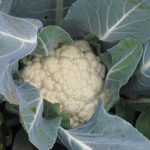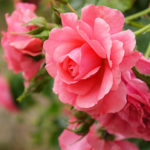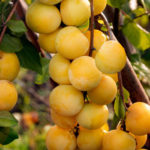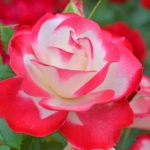Pear variety Dessert Rossoshanskaya
Dessert Rossoshanskaya - a pear with the fruits of the autumn ripening period, bred in 1952 at the Rossoshanskaya zonal experimental gardening station through crossing the Bere winter Michurina variety with Forest beauty... The authorship belongs to G.D. Neporozhny and A.M. Ulyanischeva. In 1965, the variety was transferred to the State test. In 1968 it was zoned in the Central (Bryansk region), Central Black Earth (Voronezh region) and North Caucasian regions. This pear was most widespread in plantings from 1975 - 1990, especially in gardens in the south of the Central Black Earth Region.
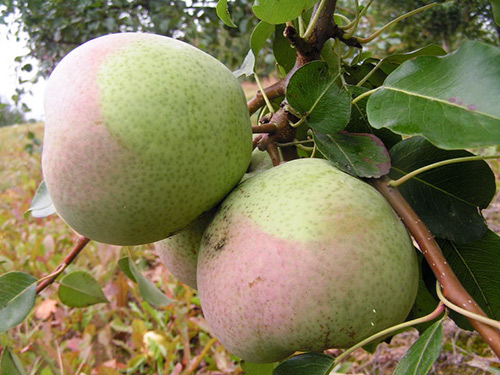
Trees are medium or vigorous and have a sparse (due to weak shoot-forming ability), wide-pyramidal crown. The bark on the trunk is dark gray, the skeletal branches are grayish brown. Skeletal branches are located vertically at an angle. Fruiting is of the ring type, the ringlets themselves are formed mainly on the branches of 2 years of age.
Shoots are thick, straight, slightly pubescent, light brown. Lentils are small in size, hardly noticeable. Buds are triangular, protruding, brown in color. Leaves are medium in size, oval, green in color, with slightly twisted tops. A leaf blade with a smooth surface, folded upward and bent downward along the midrib, without pubescence. The petioles are medium or long, with a weakly expressed color.
The flowers are relatively small (3 cm), cupped, medium double, white in color. Umbellate inflorescences, large, consist of 8 - 9 flowers. The petals are closed, folded, with solid edges. The stigma of the pistils is at the same level as the anthers; columns of pistils glabrous, pedicels medium in length. Trees bloom in medium terms.
Fruit pears Dessert rossoshanskaya average and above average size (weight is on average 140 - 160 g, but does not exceed 200 - 205 g), round or flat-rounded, short-pear-shaped or apple-shaped, with a leveled smooth surface. In the period of consumer maturity, the fruits have a light yellow basic color, the integumentary color is expressed on an insignificant part of the fruit in the form of a weak blurred pinkish blush. Quite large rusty subcutaneous dots of gray and green color are clearly visible on the skin. Peduncles are medium in length and thickness, curved. The funnel is medium in depth, wide. The saucer is medium in width and depth. Open cup.
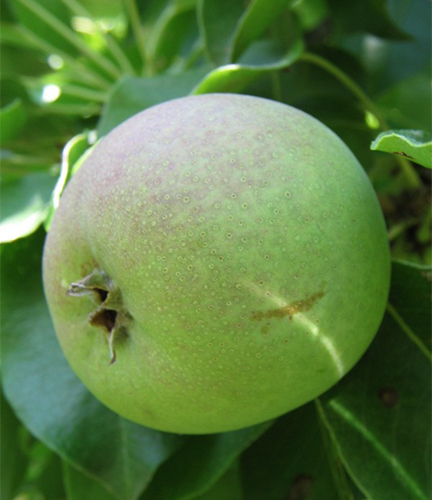
The pulp is white or slightly creamy, medium density, aromatic, tender, without stony cells, very juicy, dessert type, good or excellent sweet taste. On a 5-point tasting scale, the appearance of the fruit is estimated at 4.5 points, the taste - from 4.0 to 5.0 points. By chemical composition, the fruits contain: dry substances (14.8%), the amount of sugars (10.2%), titratable acids (0.08%), pectin substances (0.40%), ascorbic acid (10.0 mg / 100 g). For economic purposes, the variety is universal. High-quality compotes are obtained from pears (score 4.5 points), and often the fruits of this variety are used in the preparation of various desserts (marmalade, candied fruits, wine, etc.).
In the south of the Voronezh region, fruits are harvested in early September. It is recommended to pick the fruits in a somewhat immature form (rather green), after which they ripen in maturation and acquire a characteristic yellow color with a blurred blush. The consumption period does not exceed 78 days, which is typical for a group of autumn varieties, and lasts until November. Indicators of transportability and marketability of fruits are at a high level.
Dessert rossoshanskaya belongs to the self-fertile varieties. The best pollinators can be varieties: Marble, Tatiana, Autumn Yakovleva and others, blooming at the same time.
The variety is early-growing, trees enter the fruiting season early - 5-6 years after budding in a nursery. Fruiting is regular. The yield is good (up to 70 kg of fruits per tree).In the south of the Voronezh region, the average yield for many years ranged from 120 to 290 c / ha, the maximum yield did not exceed 440 c / ha.
With regard to winter hardiness: in the southern part of the Voronezh region it is high, but already in its northern part, as well as in Orel, it is average. The most serious freezing was recorded once in the harsh winter of 1976-1977 with an estimate of 3.0 points. Also, during the spring frosts in 1999 (on the night of May 7, the air temperature dropped to minus 6 ° C) and 2000 (prolonged frosts from May 2 to 20 with temperatures down to minus 2 ° C), the flowers froze and died.
The resistance of this pear to scab is extremely high; for all the years of its existence, not a single case of this disease has been recorded. Only in epiphytotic years can the variety be affected by septoria.
The variety is undemanding to soil conditions, but fertile, well-drained soils are still preferred. Trees do not tolerate excessive prolonged moisture and moisture stagnation.
The main advantages of the Dessertnaya Rossoshanskaya pear are: excellent commercial and consumer qualities of fruits, the possibility of their universal use, a high level of early maturity, exceptional resistance to scab, the autumn period of fruit consumption, good yield.
The disadvantages include its self-infertility. In order to increase winter hardiness, it is recommended to inoculate highly winter-resistant varieties into the crown.
The variety is valuable in breeding work as an initial form for high marketable and consumer qualities.


